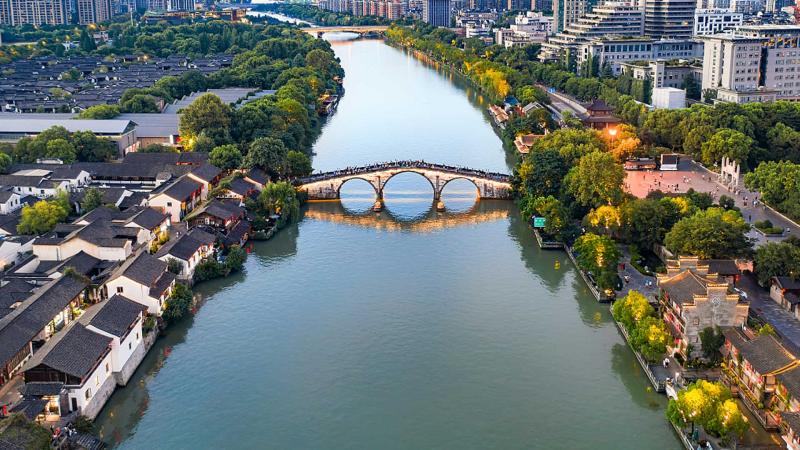Travel
World’s Oldest and Longest man-made river ‘Beijing-Hangzhou Grand Canal’ Open to Tourists in North China’s Cangzhou Downtown Section

The Cangzhou city downtown section of the world’s oldest and longest man-made river, the Beijing-Hangzhou Grand Canal, is available to navigation for tourism on September 1 and will allow guests an opportunity to appreciate the masterpiece of old China’s artificial waterway, announced an official with the Cangzhou city government of north China’s Hebei Province.
“We and more than 230 representatives from all walks of life in the city gathered to witness the historic moment of the opening of tourism in the Cangzhou central urban area of the Beijing-Hangzhou Grand Canal,” said Xiang Hui, mayor of Cangzhou at the opening ceremony, adding that the Grand Canal is now ushering in a new century of revival.
‘Beijing-Hangzhou Grand Canal’ Open to Tourists in North China
The kickoff of the 13.7-kilometer-long Cangzhou section of the Grand Canal is a significant move to propel the organized development of the Beijing-Tianjin-Hebei region in North China.
The Beijing-Hangzhou Grand Canal is 1,794 kilometers (1,115 miles) in length and has a history of 2,500 years. It begins in Beijing in the north and closed in Hangzhou in the south and served as a huge transportation artery in ancient China. Around one-eighth of the Canal goes through Cangzhou, 180 km away from Beijing. A stretch of over 1,000 km of the canal was proclaimed a world heritage site in 2014.
Cangzhou, known as “Northern Town of the Grand Canal”, has upgraded the supporting projects along the Grand Canal, recently constructed 12 tourist piers, and six landscape walking bridges, and remodeled 8 existing main bridges. The city strives to give a unique destination for tourists at home and abroad by taking the Grand Canal as the center and bringing efforts into saving historical and cultural projects, for example, the Hundred Lions Garden, Canal Park, Nanchuanlou Cultural Block, Garden Expo Park, Children’s entertainment, sports park, catering, and accommodation facilities.
Shanghai plans to reopen more organizations, and Beijing fights against Covid-19
To cause Grand Canal to recover its vitality, Cangzhou has actively implemented water diversion and water replenishment projects in recent years. Given the diversion of 180 million cubic meters of water in 2021, one more 300 million cubic meter of water was finished for this present year. More than 67,000 stems of arbor trees were established on the two sides of the Canal, with a green area of 2,065 mu (1.37 square kilometers), forming a vibrant ecological corridor, and building up the greening and upgrading projects. Cangzhou has genuinely “protected, passed down and made good use of” the Grand Canal culture and made this valuable heritage blossom into a new era.
Fifteen cruise ships have lined up by the piers for their first rides. From September 1st, tourists will actually want to experience Cangzhou’s historical and cultural relics along the Grand Canal.
-

 Business3 weeks ago
Business3 weeks agoPrakash and Kamal Hinduja: Driving Social and Environmental Change
-
Education4 weeks ago
Fred DuVal: University Leadership as a Critical Resource for Climate Change Research and Life-Saving Solutions
-

 Cryptocurrency3 weeks ago
Cryptocurrency3 weeks agoDesigned For The Masses: How Akasha (AK1111) Is Unlocking Crypto For The Next Billion Users
-

 Health3 weeks ago
Health3 weeks agoThe Hinduja Brothers Commitment to Global Health: Empowering Communities Across Borders
-

 Cryptocurrency4 weeks ago
Cryptocurrency4 weeks agoNexaglobal & Future World Token (FWT): Could This Be the Next Big Crypto Investment of 2025?
-

 Startup2 weeks ago
Startup2 weeks agoCost-Saving Strategies Every Small Business Owner Should Know to Boost Efficiency
-

 Startup3 weeks ago
Startup3 weeks agoMatthew Denegre on the Art of Deal Sourcing: Finding the Right Investment Opportunities
-

 Health2 weeks ago
Health2 weeks agoSt. John’s Community Health Examines Innovations in Pharmacy Access













